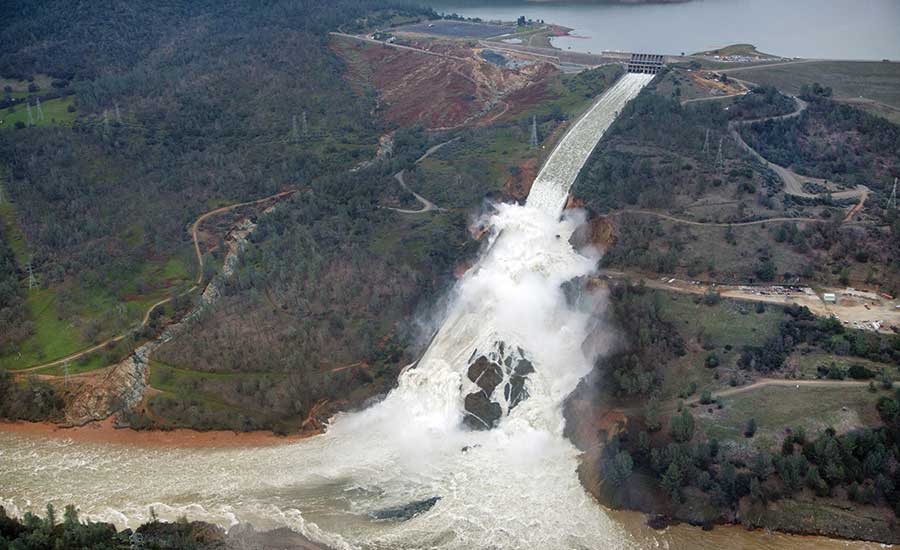An independent forensic team’s verdict on the causes of the spillway emergency last February at Oroville Dam cited “long-term systemic failure” at the California Dept. of Water Resources and laid bare the agency’s decision-making processes during the near-disaster.
The 584-page report released Friday supports the team’s earlier findings of inherent flaws in the construction and design of the tallest dam in the U.S., and points to the failure of agencies, regulators and the dam industry in general to recognize and address these weaknesses. Completed in 1968, the 770-ft-tall Oroville Dam developed cracks in its concrete chute slab almost immediately after construction, with high underdrain flows—a situation quickly deemed “normal” in regular inspection reports and receiving ineffective repairs.
Following the Feb. 7 failure of the dam’s service spillway, the report says, dam officials closed the spillway gates. But as lake levels continued to rise, decision-makers faced a choice between opening the service spillway once more or allowing the lake to overflow the never-before-used emergency spillway. Geologists, dam safety engineers and incident command personnel onsite recommended increasing spillway flows as much as safety permitted while monitoring erosion. Executives and operational personnel, on the other hand, favored allowing the lake waters to overtop the emergency spillway to protect the dam’s transmission tower and powerhouse located near the service spillway.
Decision-makers opted for the middle ground, the report says, balancing the risks of operating the service and emergency spillways. Protecting the dam’s transmission tower and powerhouse became a top priority, and dam officials released the minimum flows down the service spillway in an effort to limit ongoing erosion while not overtopping the emergency spillway. But the lake waters still rose, pouring over the emergency spillway, which consisted of a concrete lip on a hillside. The overflow badly eroded the hillside, resulting in the precautionary evacuation of about 200,000 people downstream. Dam officials were forced to release more water through the main spillway, which gouged an 1,100-ft-long, 200-ft-deep trench in the structure.
“Although there were obviously efforts to avoid using the emergency spillway, not everything was done to stop it, and, rather, there was an effort to find the ‘sweet spot,’ which ultimately failed,” the report says.
No one individual, group or organization can be blamed for the spillway failures, the investigative team says. “We’re not trying to second-guess the decisions, we’re trying to look to the future,” said civil engineer John France, who led the review team.
The report recommends that DWR adopt a more mature and “top-down” safety program. “We spoke to people at different levels—tried to cast a wide net. We asked them, ‘Who is the DWR executive who has ultimate responsibility for dam safety?’ and we got different answers,” France says.
Such a designated and accountable DWR executive would not be unduly influenced by one point of view, and would be better prepared to make the necessary risk tradeoffs in critical decisions, such as those required during the incident, the investigative team wrote. The team also recommends that DWR make dam safety information more accessible and encourage its team to pursue conferences and training outside California.
In response to the forensic team’s findings, California DWR officials said in a statement that the agency is evaluating its dam safety program and will assess its organizational structures. DWR plans to convene experts over the coming months to digest the team’s findings and identify actions in response.
“We will carefully assess this report, share it with the entire dam safety community and incorporate the lessons learned,” DWR Director Grant Davis said in a statement.
In the meantime, Oroville Dam repairs will top $500 million. A large portion of the spillway chute was successfully replaced in November before the start of California’s rainy season.
